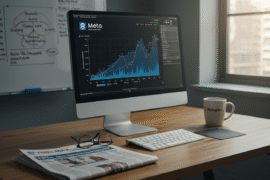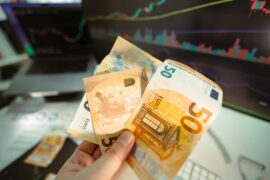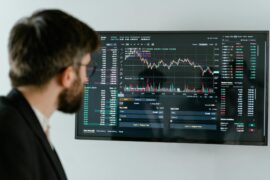This article may contain references to products or services from one or more of our advertisers or partners. We may receive compensation when you click on links to those products or services. Nonetheless, our opinions are our own.
- Nike Stock Could Be the Start of the Mother of All Comebacks
- Foundation of Nike’s Market Strength
- Signs of a Rebound
- Evolving Consumer Behavior and Nike’s Strategic Response
- Sustainability as a Driver of Brand Appeal
- Retail Recovery and Shifts in Buying Patterns
- Competition and Landscape
- Risks Investors Should Monitor
- Opportunities for Growth
- Timing Considerations for Investors
- Nike’s Path Ahead
-
Frequently Asked Questions
- What factors are currently influencing Nike’s stock performance?
- How is Nike’s approach to sustainability affecting investor interest?
- What role do international markets play in Nike’s strategy?
- What do analysts expect for Nike’s future performance?
- Which risks could challenge Nike’s stock outlook?
- Is this a favorable time to consider Nike stock?
- Recommended Reads
Nike Stock Could Be the Start of the Mother of All Comebacks
Nike continues to stand as a towering name in the athletic apparel and footwear industry. Investors and market watchers alike are keenly interested in whether the brand’s recent momentum can translate into sustained stock performance. This analysis explores Nike’s latest financial data, evolving market dynamics, and the factors that could shape its trajectory.
Foundation of Nike’s Market Strength
Since its rebranding in 1971 from Blue Ribbon Sports, Nike has cultivated a reputation built on innovation, marketing brilliance, and cultural resonance. From the rise of Air Jordans to partnerships with iconic athletes, Nike’s ability to capture consumer imagination has solidified its stature in the competitive landscape of sportswear. Yet even household names face hurdles, and recent years have brought a series of challenges. Global supply chain constraints, shifts in retail behavior, and economic uncertainty have tested Nike’s operational flexibility.
Signs of a Rebound
Nike’s financial reports for the latest quarter revealed several encouraging signs:
- Revenue Growth: Sales surpassed $12 billion, with strong contributions from the footwear segment leading the charge. This performance defied some analysts’ expectations of stagnation.
- Digital Acceleration: Online sales jumped nearly 40% year-over-year. This surge illustrates the success of Nike’s strategic focus on direct-to-consumer channels, allowing the company to capture higher margins and engage consumers more personally.
- Profit Margins: Despite persistent supply chain headwinds, Nike’s gross margins remained stable. The company’s pricing discipline and strategic inventory management helped offset rising production and shipping costs.
These results suggest Nike is not only withstanding economic fluctuations but also regaining its growth momentum.
Evolving Consumer Behavior and Nike’s Strategic Response
Consumers are increasingly prioritizing health and active lifestyles, a trend accelerated by recent global health crises. Demand for high-performance gear and athleisure has climbed, and Nike’s marketing campaigns emphasize wellness in ways that resonate with modern buyers.

Sustainability has become a powerful influence on purchasing decisions. Nike’s launch of eco-conscious collections crafted from recycled materials is more than a marketing play; it aligns with consumers who expect brands to reflect their values.
Sustainability as a Driver of Brand Appeal
Nike’s “Move to Zero” initiative underscores its commitment to reducing carbon emissions and waste across its supply chain. By integrating recycled polyester, innovative dyeing processes, and other sustainable practices, Nike is positioning itself favorably among investors with Environmental, Social, and Governance (ESG) priorities. The significance of these initiatives extends beyond public relations. By reducing material costs and improving efficiency, sustainability efforts can support Nike’s long-term profitability.
Retail Recovery and Shifts in Buying Patterns
Recent data suggests a rebound in brick-and-mortar retail traffic, as shoppers return to stores for immersive experiences and exclusive product launches. Nike’s focus on flagship locations and “House of Innovation” concepts has amplified in-store engagement, converting foot traffic into revenue. Meanwhile, the enduring popularity of sneaker culture continues to benefit Nike. Limited releases and collaborations consistently generate excitement, driving both direct sales and secondary market activity.
Competition and Landscape
Nike operates in an intensely competitive sector alongside Adidas, Puma, and new entrants leveraging digital channels. While Adidas has gained attention with sustainability-focused offerings, and Puma has benefited from fashion collaborations, Nike’s advantages in scale, athlete partnerships, and digital investments continue to set it apart.
| Brand | Revenue Performance | Differentiating Strengths |
|---|---|---|
| Nike | Exceeded $12B revenue | Strong digital ecosystem, deep athlete endorsements |
| Adidas | Mid-single-digit growth | Sustainability messaging, design innovation |
| Puma | Steady but lower sales growth | Fashion-driven appeal, niche targeting |
Risks Investors Should Monitor
While Nike’s resilience is evident, several risks could impact future performance:
- Supply chain disruptions, including transportation bottlenecks or material shortages, could pressure inventory levels and margins.
- Volatile commodity prices, particularly for synthetic and natural materials, pose a threat to cost stability.
- Economic downturns in markets could soften consumer spending on premium-priced products.
By recognizing these potential obstacles, investors can better track fluctuations in Nike’s stock.
Opportunities for Growth
Nike has multiple levers for sustained growth:
- Expansion in high-growth regions such as China and India, where rising middle-class incomes fuel demand for branded sportswear.
- Enhanced personalization of shopping experiences, combining data analytics and mobile integration to drive conversion rates.
- Continued innovation in product technology, such as performance-enhancing footwear, maintains consumer enthusiasm and brand differentiation.
Timing Considerations for Investors
Historically, Nike’s stock has benefited from periods aligned with seasonal demand surges, including back-to-school and holiday shopping seasons. Investors tracking consumer sentiment reports, marketing campaigns, and upcoming product launches may identify favorable entry points during market dips.
Nike’s Path Ahead
Nike’s recent earnings beat expectations and reinforced the strength of its digital strategy, pricing power, and ability to adapt to shifting consumer trends. While challenges remain, the brand’s commitment to innovation, global expansion, and sustainability initiatives provides a solid foundation for continued growth. For those evaluating potential additions to a diversified investment portfolio, Nike offers exposure to a leading brand with a track record of resilience and opportunities for future appreciation.
Frequently Asked Questions
What factors are currently influencing Nike’s stock performance?
Recent earnings exceeding estimates, strong direct-to-consumer growth, and increased demand for athletic apparel are among the most significant drivers of Nike’s stock price.
How is Nike’s approach to sustainability affecting investor interest?
Nike’s efforts to reduce waste and emissions have resonated with consumers and institutional investors, strengthening its reputation and potentially supporting a premium valuation.
What role do international markets play in Nike’s strategy?
Markets in Asia and Europe are central to Nike’s expansion, offering opportunities for localized products and campaigns that can increase market share and revenue.
What do analysts expect for Nike’s future performance?
Analyst sentiment remains broadly positive, citing digital transformation and strong consumer loyalty as factors likely to sustain revenue and earnings growth.
Which risks could challenge Nike’s stock outlook?
Potential risks include prolonged supply chain disruptions, rising costs of raw materials, intensified competition, and macroeconomic instability that could dampen discretionary spending.
Is this a favorable time to consider Nike stock?
Investors should review upcoming financial reports and monitor retail and economic indicators to gauge momentum before making decisions, aligning purchases with individual investment objectives.

Reviewed and edited by Albert Fang.
See a typo or want to suggest an edit/revision to the content? Use the contact us form to provide feedback.
At FangWallet, we value editorial integrity and open collaboration in curating quality content for readers to enjoy. Much appreciated for the assist.
Did you like our article and find it insightful? We encourage sharing the article link with family and friends to benefit as well - better yet, sharing on social media. Thank you for the support! 🍉
Article Title: Nike Stock: The Mother of All Comebacks Might Have Just Begun
https://fangwallet.com/2025/07/02/nike-stock-the-mother-of-all-comebacks-might-have-just-begun/The FangWallet Promise
FangWallet is an editorially independent resource - founded on breaking down challenging financial concepts for anyone to understand since 2014. While we adhere to editorial integrity, note that this post may contain references to products from our partners.
The FangWallet promise is always to have your best interest in mind and be transparent and honest about the financial picture.
Become an Insider

Subscribe to get a free daily budget planner printable to help get your money on track!
Make passive money the right way. No spam.
Editorial Disclaimer: The editorial content on this page is not provided by any of the companies mentioned. The opinions expressed here are the author's alone.
The content of this website is for informational purposes only and does not represent investment advice, or an offer or solicitation to buy or sell any security, investment, or product. Investors are encouraged to do their own due diligence, and, if necessary, consult professional advising before making any investment decisions. Investing involves a high degree of risk, and financial losses may occur including the potential loss of principal.
Source Citation References:
+ Inspo
NIKE, Inc. (2025, June 26). NIKE, Inc. Reports Fiscal 2025 Fourth Quarter and Full Year Results [Press release]. Investor Relations.
U.S. Securities and Exchange Commission. (2024, May 31). NIKE, Inc. Form 10-K [SEC filing].











































